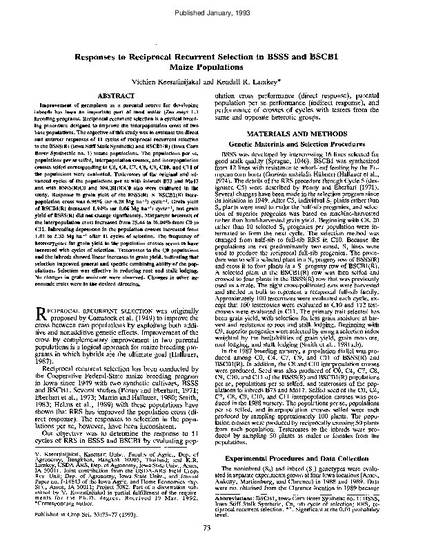
Improvement of germplasm as a parental source for developing inbreds has been an important part of most maize (Zea mays L.) breeding programs. Reciprocal recurrent selection is a cyclical breeding procedure designed to improve the interpopulation cross of two base populations. The objective of this study was to evaluate the direct and indirect responses of 11 cycles of reciprocal recurrent selection in the BSSS(R) (Iowa Stiff Stalk Synthetic) and BSCB1(R) (Iowa Corn Borer Synthethic no. 1) maize populations. The populations per se, populations per se selfed, interpopulation crosses, and interpopulation crosses selfed corresponding to C0, C4, C7, C8, C9, C10, and C11 of the populations were evaluated. Testcrosses of the original and advanced cycles of the populations per se with inbreds B73 and Mo17 and with BSSS(R)C0 and BSCB1(R)C0 also were evaluated in the study. Response in grain yield of the BSSS(R) × BSCB1(R) interpopulation cross was 6.95% (or 0.28 Mg ha-1) cycle-1. Grain yield of BSCB1(R) increased 1.94% (or 0.06 Mg ha-1) cycle-1, but grain yield of BSSS(R) did not change significantly. Midparent heterosis of the interpopulation cross increased from 25.44 to 76.04% from C0 to C11. Inbreeding depression in the population crosses increased from 1.01 to 2.32 Mg ha-1 after 11 cycles of selection. The frequency of heterozygotes for grain yield in the population crosses seems to have increased with cycles of selection. Testcrosses to the C0 populations and the inbreds showed linear increases in grain yield, indicating that selection Improved general and specific combining ability of the populations. Selection was effective in reducing root and stalk lodging. No changes in grain moisture were observed. changes in other agronomic traits were in the desired direction.
Available at: http://works.bepress.com/kendall_lamkey/70/

This article is published as Keeratinijakal, Vichien, and Kendall R. Lamkey. "Responses to reciprocal recurrent selection in BSSS and BSCB1 maize populations." Crop Science 33, no. 1 (1993): 73-77. doi: 10.2135/cropsci1993.0011183X003300010012x. Posted with permission.